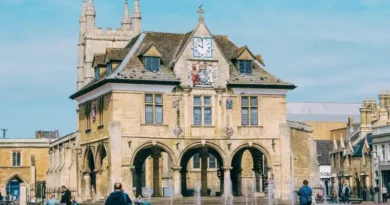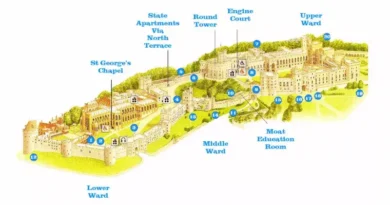How is Windsor Castle Heated?
Windsor Castle has used a Combined Heat and Power (CHP) system since 1994-95. This system converts natural gas into electricity, and the heat produced during this process provides heating and hot water throughout the castle. CHP systems are known for their efficiency, as they simultaneously generate electricity and thermal energy, reducing overall energy consumption and carbon emissions.
This modern system complements the historical heating methods at Windsor Castle, such as fireplaces, ensuring both energy efficiency and preservation of the castle’s heritage.
Key Takeaways
| Aspect | Details |
|---|---|
| Heating System Type | Combined Heat and Power (CHP) system. |
| Installation Date | 1994-95. |
| Fuel Source | Natural gas. |
| Efficiency | Produces both electricity and thermal energy from a single fuel source. |
| Historic Fireplaces | Present but not the primary heating source. |
| Modern Heating Systems | Central heating with radiators, carefully integrated to preserve historical appearance. |
| Supplementary Energy Sources | Hydroelectric power from the River Thames and solar panels (installed in 2024). |
| Sustainability | Reduces carbon footprint and reliance on the National Grid. |
| Maintenance Responsibility | Royal Household’s property services team. |
| Architectural Considerations | Balances heritage preservation with modern, efficient heating solutions. |
| Seasonal Adjustments | Heating adjusted to maintain comfortable indoor temperatures. |
| 1992 Fire | Unrelated to the heating system; modern safety measures prevent similar incidents. |
The Heating System at Windsor Castle: A Blend of Tradition and Innovation
Windsor Castle, one of the world’s most iconic and historic royal residences, seamlessly combines the old with the new in its architecture and approach to heating. The castle, which has served as a royal home for nearly a thousand years, has had to adapt to the demands of modern living while preserving its historical integrity. This balance is particularly evident in how the castle is heated—a system that integrates traditional methods with state-of-the-art technology.

The Role of Traditional Fireplaces
Windsor Castle has long relied on traditional fireplaces to provide warmth throughout its vast rooms and halls. These fireplaces, many of which are centuries old, continue to play a significant role in the castle’s heating system. In the colder months, these grand fireplaces are often lit, creating a warm and inviting atmosphere while maintaining the historical ambience of the castle. The sight of a roaring fire in one of Windsor Castle’s opulent rooms is a nod to tradition and a functional part of the castle’s heating strategy.
However, as anyone familiar with fireplaces’ limitations would know, they are not sufficient to heat a building as large and complex as Windsor Castle on their own. While they contribute to the warmth of the rooms they are located in, they are not efficient enough to provide consistent heating throughout the castle, especially in spaces far from these fireplaces.
Introduction of Modern Central Heating Systems
To address the limitations of fireplaces, Windsor Castle has been fitted with modern central heating systems. These systems include radiators, providing a more reliable and evenly distributed warmth across the castle. The installation of these systems was done with care to ensure that they did not detract from the historical character of the building. These modern heating elements are often hidden from view or designed to blend seamlessly with the castle’s décor.
Central heating allows for better temperature control, ensuring that all areas of the castle, including those not directly served by fireplaces, remain comfortable year-round. This modern infrastructure is essential not only for the comfort of the castle’s residents and staff but also for the preservation of the castle itself, as maintaining a stable internal environment helps protect the building and its contents from the damaging effects of cold and dampness.
Combined Heat and Power: A Sustainable Solution
Windsor Castle and Buckingham Palace adopted a Combined Heat and Power (CHP) system in the mid-1990s to move towards energy efficiency and sustainability. The CHP system, used at Windsor Castle since 1994-95, represents a forward-thinking approach to energy management within the Royal Household.
CHP units work by converting natural gas into electricity. Generating electricity produces a substantial amount of heat as a byproduct. Instead of allowing this heat to go to waste, the CHP system captures it and uses it to provide heating and hot water throughout the castle. This dual-purpose approach significantly increases energy efficiency by generating electricity and thermal energy from the same fuel source.
Adopting the CHP system at Windsor Castle reflects a broader commitment to reducing energy consumption and minimizing environmental impact. By generating electricity on-site and utilizing the heat produced, the castle reduces its reliance on external energy sources and lowers its overall carbon footprint.
Balancing Modern Needs with Historical Preservation
The heating system at Windsor Castle is a testament to the careful balance between maintaining the historical integrity of a heritage site and incorporating modern amenities that ensure comfort and sustainability. The combination of traditional fireplaces, modern central heating, and the innovative CHP system provides a comprehensive solution that meets the needs of a 21st-century royal residence while respecting its centuries-old legacy.
As Windsor Castle continues to serve as both a residence and a symbol of British history, its heating system exemplifies how historical preservation and modern technology coexist harmoniously. This approach not only preserves the past but also ensures that the castle remains a functional and livable space for future generations of the royal family.
FAQ
How is Windsor Castle heated?
Windsor Castle is heated using a Combined Heat and Power (CHP) system, operational since 1994-95. This system converts natural gas into electricity and uses the resultant heat for heating and hot water.
What is Combined Heat and Power (CHP)?
CHP is an efficient process that generates electricity and captures the resulting heat for thermal energy. It provides greater efficiency and reduces energy costs and environmental impact.
When was the CHP system installed at Windsor Castle?
The CHP system was installed during 1994-95 and has since supplied electricity and heating, reducing energy costs and emissions.
Does Windsor Castle use renewable energy sources?
Yes, Windsor Castle uses renewable energy sources, including hydroelectric power from turbines on the River Thames at Romney Weir, which provide about 40% of the castle’s electricity.
Are there any solar panels at Windsor Castle?
Yes, in 2024, photovoltaic panels were installed on Lord Chamberlain’s Upper Store roof, replacing the old lead roof.
How does the castle’s architecture affect its heating?
The historic architecture requires careful integration of modern systems like CHP and renewable energy, balancing preservation and efficiency.
Has the heating system been updated recently?
Yes, recent updates include boiler work to ensure the system’s efficiency and optimal performance.
What measures are in place to improve energy efficiency?
Energy efficiency measures include the CHP system, hydroelectric power, and solar panels, reducing emissions, costs, and reliance on the National Grid.
Is there a backup heating system?
While details aren’t disclosed, large estates like Windsor Castle typically have contingency plans to ensure continuous heating.
How does the castle manage heating in different seasons?
Heating is adjusted seasonally to maintain optimal indoor temperatures, balancing comfort and efficiency.
Are there fireplaces in use at Windsor Castle?
Historic fireplaces exist but are not the primary heating source, as modern systems like CHP are safer and more efficient.
How does the castle’s heating system contribute to sustainability?
The system utilises CHP, hydroelectric, and solar power to reduce greenhouse gas emissions, lower costs, and minimise reliance on non-renewable energy.
Who is responsible for maintaining the heating system?
The Royal Household’s property services team oversees the maintenance of the heating system, ensuring efficient operation.
Has the heating system ever caused any issues, like fires?
The 1992 fire at Windsor Castle was unrelated to the heating system. Modern safety measures are in place to prevent such incidents.
Are there any plans for future upgrades to the heating system?
Future upgrades will focus on adopting advanced technologies and renewable energy to enhance efficiency and sustainability.
How does the heating system handle the castle’s large size?
The CHP system, supported by renewable energy, effectively distributes heat across the castle, maintaining consistent temperatures.









